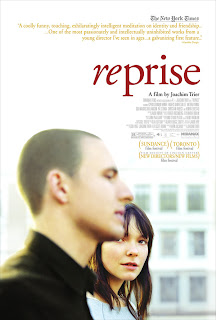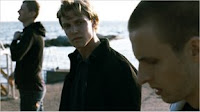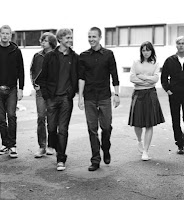
I knew almost nothing about the Norwegian film Reprise before going into the theatre, which is a good thing, because if anybody had told me its central characters are a couple of young novelists, one of whom struggles with mental illness, I would have said, "No thanks, I'll wait for the DVD" and I would have missed the best movie I've seen in months.
Before I get into what makes Reprise so good, I have to pause to describe the audience I and my companion were stuck in while watching the film. We arrived at Lincoln Plaza half an hour before the show, got tickets, and then waited in what seemed, even for New York, a pretty long line for an afternoon on a beautiful day. We also seemed to be the youngest people in the line, which also seemed odd, because, as far as we knew, this was more the sort of movie to attract a crowd of hipster Cinema Studies majors than, well, grandparents -- but this is New York, after all, and if there's anywhere in the world where grandparents will turn out en masse for a Norwegian movie about angsty twenty-somethings, New York is it.
This would have been simply amusing if, no more than fifteen minutes into Reprise, it had not become very clear that many of the audience members expected something different from the movie than what they were getting, and when they were not sighing, coughing, shuffling their feet, checking their phones (really!), or falling asleep on my shoulder (really!), the people around us were whispering loudly in an attempt to figure out some of the basic elements of the movie -- "Who is he?" "Did he have a car accident?" "Are they taking drugs?" "I thought this was in French -- it's not in French. What are they saying?"
(An aside to this aside: I am extremely sensitive to audience noise. Whispering, chewing, foot-tapping, fidgeting, candy-unwrapping, sighing, coughing -- all these sounds and movements cause me pain while watching movies and plays -- the person who introduced popcorn to movie theatres deserves, I believe, a circle of hell unto him- or herself -- but I know it's something that is peculiar to me, and so I seldom comment on it, thinking it's my own problem. My companion, though, who is a much more balanced and tolerant human being than I, commented on the awfulness of the audience the moment we left the theatre.)
It is a mystery to me what caused this particular audience to gather for this particular movie. (If you are telling people that Reprise is the Norwegian On Golden Pond, please stop doing so!) But despite being stuck in the middle of a dreadful audience, I was still able to find Reprise engaging and thought-provoking, and that fact alone is a testament to the movie's quality.
The basic story Reprise tells is a simple one: two friends in Oslo want to be writers. One, Phillip, succeeds quite quickly with his first novel, then falls in love with and starts dating Kari, a young woman who's not quite sure of her place in the world, and his love becomes obsessive and he begins acting irrationally, then has a breakdown. He recovers from his breakdown slowly and never completely. Meanwhile, Erik eventually publishes his first novel, dates a woman he's not really in love with, wonders what he's doing with his life, thinks about getting out of Oslo. Phillip and Erik's friends from elementary school days are also trying to figure out what to do with their lives.
I have now succeeded in making the movie sound, I expect, quite tedious. (You are starting to sympathize with the sighers and whisperers in the audience!) But Reprise is not tedious at all, and the reason is that the story is simply a skeleton of events that gives support to an exploration of the characters, and it is this exploration that provides the film's substance. The structure that writer-director Joachim Trier and his co-writer, Eskil Vogt, created emphasizes the vagaries of memory and yearning within the character's lives, and this structure and emphasis gives a coherence to what is, really, a fragmentary narrative. The first moments of the movie lay out Phillip and Erik's grand, naive hopes for the manuscripts they have written -- that the envelopes will be opened immediately by a top editor who will be awe-struck at the novels' brilliance and publish them to world-wide acclaim that will cause the writers to become cult heroes and even to inspire revolutions in African countries. The reality, of course, becomes more complex, but as we move through this reality, it is peppered with flashbacks and what-ifs, many of them rich with a playful and ironic tone, until, in the end, a narrator returns us to the future perfect tense of the first minutes, but now what is described are less naive scenes, scenes of friendship and maturity, and these scenes are imbued with suspense because we know that what we are watching is wished for, hoped for, ached for -- and by that point, we're wishing, hoping, and aching, too. There is as wide a range of tones in Reprise as in any other movie I can think of, and it is a wonder they all work together so well. Again, this is a virtue of the film's structure. From early on, we are prepared for light and lively scenes contrasted with moments of quiet: long shots and slow movements, bits of meditation in amidst the storm of living. Hyper-stylization becomes a tool of realism: this is what it feels like to be alive, the movie says. The long, slow shadows of a bedroom at night juxtapose with the fluorescent glare in the bathroom. The vast, cataclysmic hustle and screech of a city's heavy-metal rush turns into a slow, almost static musical phrase from just far enough away to pull patterns from chaos. Friendship becomes smothering in a moment, love flips into obsession with an eyelid's flash, the joy of success shatters into a thousand shards of insanity after too many pressures on too many points. And vice versa and vice versa and vice versa.
There is as wide a range of tones in Reprise as in any other movie I can think of, and it is a wonder they all work together so well. Again, this is a virtue of the film's structure. From early on, we are prepared for light and lively scenes contrasted with moments of quiet: long shots and slow movements, bits of meditation in amidst the storm of living. Hyper-stylization becomes a tool of realism: this is what it feels like to be alive, the movie says. The long, slow shadows of a bedroom at night juxtapose with the fluorescent glare in the bathroom. The vast, cataclysmic hustle and screech of a city's heavy-metal rush turns into a slow, almost static musical phrase from just far enough away to pull patterns from chaos. Friendship becomes smothering in a moment, love flips into obsession with an eyelid's flash, the joy of success shatters into a thousand shards of insanity after too many pressures on too many points. And vice versa and vice versa and vice versa.
The changing tones and the general lack of sentimentality are what allow Reprise to be far more than a movie about writers. That Phillip and Erik are writers is important because it allows their struggles with ideas to be dramatized -- their books become external versions of their philosophies and hopes, and when it becomes clear that Phillip has not read Erik's novel, the shock is stunning; Phillip's and Erik's struggles with the public reception of their writing dramatizes the conflict between their dreams and their realities; etc. -- but the movie stays away from offering a romanticized view of writers, and, indeed, through their friends shows that though writers may have struggles specific to their sort of occupation, it doesn't make their occupation a particularly enlightened one. (Although it does seem, at least in Norway, fairly lucrative -- both Phillip and Erik, despite not being bestselling writers, appear to be living off of their royalties. Though Erik lives with his mother, Phillip is somehow able to afford quite a nice apartment.) Though it is a very literate film -- how many movies namedrop Maurice Blanchot? -- it never feels pretentious (which is not to say its characters, being young, are not sometimes pretentious), because it never privileges writers above other human beings. There's nothing mystical or romantic about the literary life in Reprise, nor is it the only life there is.
Reprise does so many things well that I could go on and on and on (the acting, for instance, is a wonder), but I'll point briefly to two elements: The film's portrayal of long-term friendship and its handling of mental illness.
Phillip and Erik have been friends since elementary school, and they have other friends who go back nearly as long. Friendships that last through childhood and into adulthood are strange, wondrous things. We wake up one day and discover that our best friends, the people who know us most deeply, are not people we might ever have sought out now, as adults. Our interests are different, our perspectives on the world, our senses of humor and etiquette -- and yet the bond is deeper than anything we could deliberately cultivate with people more like who we have turned out to be. Reprise presents just this sort of friendship, and it does so with rare complexity and subtlety, showing the group from within and without -- the ragtag band that comes to get Phillip when he's ready to be released from the psychiatric ward and that never makes him feel anything but welcome and loved is the same group that causes horror in a smart assistant editor who, in a brief encounter, thinks that Erik's friends are uncouth and boorish. Phillip's breakdown and never-quite-successful struggle to recover are presented with similar sensitivity. Movies about crazy artists are hardly a rarity, but movies that don't turn the character's illness into either a freakshow or a badge of outsider honor are, indeed, rare. The audience is not led to see Phillip's illness as a necessary aid to his creativity -- it seems, actually, to end his creativity. We are not encouraged to marvel at his oddness or wish that he would stop taking his meds so he could embrace his inner weirdo. Instead, we see a character who is more than a cliche. He lives, having good moments and bad, ordinary moments, moments of clarity even, and yet the shadow of the breakdown is always there. We see the strain on friends and family that the alienating force of illness causes -- the difficulty at communicating from or to a personal cosmos of pain, the soon-to-be-regretted actions brought on by the pressure obsession exerts on reality, the exhaustion attendant with constantly second-guessing your perceptions. The effect, emotionally, is more complex and profound than anything offered by the more melodramatic representations of mental illness we usually get in movies.
Phillip's breakdown and never-quite-successful struggle to recover are presented with similar sensitivity. Movies about crazy artists are hardly a rarity, but movies that don't turn the character's illness into either a freakshow or a badge of outsider honor are, indeed, rare. The audience is not led to see Phillip's illness as a necessary aid to his creativity -- it seems, actually, to end his creativity. We are not encouraged to marvel at his oddness or wish that he would stop taking his meds so he could embrace his inner weirdo. Instead, we see a character who is more than a cliche. He lives, having good moments and bad, ordinary moments, moments of clarity even, and yet the shadow of the breakdown is always there. We see the strain on friends and family that the alienating force of illness causes -- the difficulty at communicating from or to a personal cosmos of pain, the soon-to-be-regretted actions brought on by the pressure obsession exerts on reality, the exhaustion attendant with constantly second-guessing your perceptions. The effect, emotionally, is more complex and profound than anything offered by the more melodramatic representations of mental illness we usually get in movies.
There are many other complexities to the film as well -- for instance, there is an ongoing but understated exploration of gender relations (it's a movie about heterosexual men, yes, but it never pretends their immaturity about women or sexuality is anything other than immature, and the women in the film call the men on their bullshit) -- but I fear that continuing to celebrate its many extraordinary pieces will distract from the effect of the film as a whole, because what is most extraordinary about Reprise is not that it contains smart and artfully crafted pieces, but that the pieces all join together in a whole that is more artful, evocative, and affecting than any discussion of the pieces can convey.
Viewing: Blog Posts Tagged with: collective nouns, Most Recent at Top [Help]
Results 1 - 8 of 8
Blog: The Mumpsimus (Login to Add to MyJacketFlap)
JacketFlap tags: Norway, Joachim Trier, Reprise, Movies, film, Add a tag
Blog: le pen quotidien (Login to Add to MyJacketFlap)
JacketFlap tags: daily drawings, critters, collective nouns, Add a tag
It has been awhile, so I thought it was time for another in the collective nouns series. I’m feeling rather sleepy today after all the recent action, so I thought a nice peaceful drift of hogs was appropriate…
The rest of the series can be found here.
Blog: le pen quotidien (Login to Add to MyJacketFlap)
JacketFlap tags: daily drawings, collective nouns, Add a tag

It’s comforting to keep in mind that however much your job may get you down, at least you’re not an insurance adjuster for rhinoceros accidents. They’re shockingly careless, and never accept responsibility.
Another in my ongoing series of illustrations based on the sometimes poetic and often ridiculous (yet always fitting) collective nouns for animals…
Blog: le pen quotidien (Login to Add to MyJacketFlap)
JacketFlap tags: daily drawings, critters, collective nouns, Add a tag
When I was a kid we lived about 15 miles outside of a small town. We owned a Volkswagen Rabbit that had been acting up, and we also owned a goat. The goat was named Boomer, and he was about the worst animal on the planet—I was even aware of this at the time, but I still loved him. I had made a rope halter in 4-H and was determined to halter-train him, and I would have to literally drag him down the road away from our place, all four of his hooves digging into the dirt in front of him and his head cocked to the side with eyes bulging, and then when we got to the end of the road and turned back, he would take off running, and practically rip my arms out of their sockets until I let go of the rope. Training a goat is not an easy task.
Boomer and my father were mortal enemies. He was always leading the other goats out of the pen, but we could never catch them in the act and see how they were escaping. I can remember my dad out there, stealthily sneaking on tiptoes around the shed to secretly watch the escape plan, and after he had reached his lookout spot, he would wait a sufficient amount of time for all suspicion to die. He would then ever so slowly eke his head around the corner just enough so his eye could make out the corner of the pen, and there would be Boomer staring straight at him. Every single time.
Anyway, the Volkswagen. One day my dad was fixing the carburetor, he had it all taken apart and was following his propped-open Compleat Idiot manual step by step. He realized he didn’t have the proper tool for one part, so hopped in the farm truck to go borrow one from a friend. Out where we lived people often had uninsured vehicles for home use only, so it’s not like he could drive this into town—just to clarify the Rabbit was our only real vehicle. So, he zipped over to a friend’s place, it took him ten minutes—and by the time he got back, Boomer had not only escaped from the pen, but he had also eaten the page detailing how to put the thing back together again. Have you ever seen a man who has been tormented by a goat, and the goat won? It is NOT pretty.
It has been awhile since I did a drawing in the collective nouns series. The rest can be found here.
Blog: le pen quotidien (Login to Add to MyJacketFlap)
JacketFlap tags: daily drawings, critters, collective nouns, Add a tag
For some reason when I think of bears, I think of being in the small town in the interior where I grew up. It was a few years ago, and I was staying with a friend who lives many miles out of town, up a very remote road where she lives with her llamas. Yes, llamas. She has an incredible straw bale house (that my father helped her build) on top of a hill, surrounded by beautiful pine trees and overlooking the snaking St. Mary’s river. I had been visiting friends in town and returned after dark, so I had been given a can of bear spray, just in case—there are often bears lurking around there, and you never know what they’ll do. I parked the car outside her fence, and loaded my arms up with the multiple items I needed to carry up the hill with me. Now, remember this is in the middle of nowhere—there aren’t exactly streetlights, as you can imagine. So, here I am, with an armload of teetering detritus, and I have to try to navigate in the pitch black towards the gate in the fence, through tall grass and over uneven ground. I get through the gate, and as I turn from latching it, I lose my footing and I can feel myself stagger. I will never forget that moment, as the realization hit that I was stumbling in the direction of a high-voltage electric fence—but knowing that the only option other than falling into the fence was forcing myself to reel in the other direction, which would very likely result in me bear-spraying myself in the face. At the last possible moment I caught my balance, and though I laughed out loud, it was a laugh filled with that sickly rush you get after a near miss while driving.
Looking back, I almost can’t believe I managed to avoid it—macing myself in the face is so something I would be capable of.
This week’s theme for Illustration Friday is “100%”, and after I spent an hour wandering around today trying to find a sign somewhere that said 100% anything (there should be many: 100% organic, 100% Canadian owned, 100% guarantee—I guess no one wants to claim 100% anything these days), I returned to work thinking that the expedition had been 100% useless. Which made me realize I have been meaning to draw a group of 100% useless characters: a sloth of bears (not to be confused with a sleuth of bears, which is much more active—and inquisitive).
Blog: le pen quotidien (Login to Add to MyJacketFlap)
JacketFlap tags: daily drawings, critters, collective nouns, Add a tag

So, it seemed time to revisit the collective nouns. By most accounts, the poetic terms for groups of animals (and other things) were mainly created by writers in centuries past, but I suspect that this one dates from the glory days of Southern Florida in the 1970’s, when you were every bit as likely to see another type of green bale bobbing offshore as you were a group of turtles. Coined also by writers—the writers of Miami Vice.
Blog: le pen quotidien (Login to Add to MyJacketFlap)
JacketFlap tags: daily drawings, critters, collective nouns, Add a tag
“I’m tired of eating just beans,” says I,
So I opened a can of sardines.
But they started to squeak,
“Hey, we are tryin’ to sleep.
We were snuggled up tight
Till you let in the light.
You big silly sap, let us finish our nap.
Now close up the lid!”
So that’s what I did…
Will somebody please pass the beans?
- Shel Silverstein
Where the Sidewalk Ends was one of my favourite books as a kid, and I still know many of the poems by heart. The humour in them was so subtle and perfect, and the fact that the author looked more like a criminal than a writer of children’s poetry only increased his appeal. I once read an interview with Shel Silverstein, and he said that his publishing contracts stipulated that he had final say over the book’s design, and moreover that his books were never to be published in paperback—and a glance through Amazon seems to indicate that this agreement has not been broken. Turning down additional book sales to protect the book’s design is a hell of a move, in my opinion. I knew I liked that guy for a reason.
This is another in my collective nouns series, for this week’s Illustration Friday theme “little things”.
Blog: le pen quotidien (Login to Add to MyJacketFlap)
JacketFlap tags: daily drawings, critters, collective nouns, Add a tag
For those of you who have spent much of your time wondering why bees allow grasshoppers to hang out with them, now you know: it’s because they can reach the pedals.
Another in my ongoing collective noun series, this one is for this week’s Illustration Friday theme, “little things”.








'Hyper-stylization becomes a tool of realism: this is what it feels like to be alive, the movie says.'
Yes! The very reason I read your blog.
(And it could use a long essay of its own...)